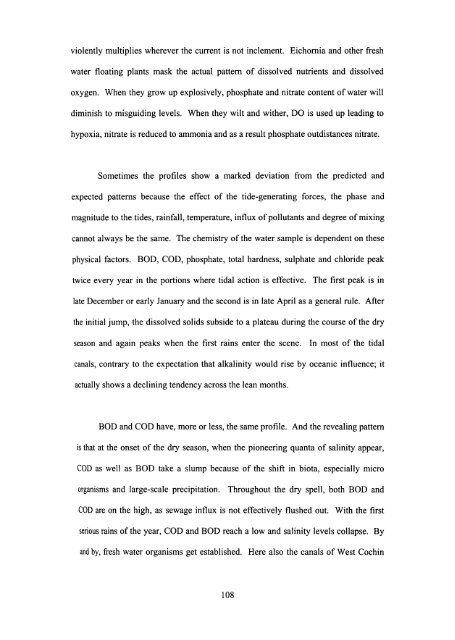Salinity Intrusion and Seasonal Water Quality Variations in the Tidal ...
Salinity Intrusion and Seasonal Water Quality Variations in the Tidal ...
Salinity Intrusion and Seasonal Water Quality Variations in the Tidal ...
You also want an ePaper? Increase the reach of your titles
YUMPU automatically turns print PDFs into web optimized ePapers that Google loves.
violently multiplies wherever <strong>the</strong> current is not <strong>in</strong>clement. Eichornia <strong>and</strong> o<strong>the</strong>r fresh<br />
water float<strong>in</strong>g plants mask <strong>the</strong> actual pattern of dissolved nutrients <strong>and</strong> dissolved<br />
oxygen. When <strong>the</strong>y grow up explosively, phosphate <strong>and</strong> nitrate content of water will<br />
dim<strong>in</strong>ish to misguid<strong>in</strong>g levels. When <strong>the</strong>y wilt <strong>and</strong> wi<strong>the</strong>r, DO is used up lead<strong>in</strong>g to<br />
hypoxia, nitrate is reduced to ammonia <strong>and</strong> as a result phosphate outdistances nitrate.<br />
Sometimes <strong>the</strong> profiles show a marked deviation from <strong>the</strong> predicted <strong>and</strong><br />
expected patterns because <strong>the</strong> effect of <strong>the</strong> tide-generat<strong>in</strong>g forces, <strong>the</strong> phase <strong>and</strong><br />
magnitude to <strong>the</strong> tides, ra<strong>in</strong>fall, temperature, <strong>in</strong>flux ofpollutants <strong>and</strong> degree of mix<strong>in</strong>g<br />
cannot always be <strong>the</strong> same. The chemistry of <strong>the</strong> water sample is dependent on <strong>the</strong>se<br />
physical factors. BOO, COD, phosphate, total hardness, sulphate <strong>and</strong> chloride peak<br />
twice every year <strong>in</strong> <strong>the</strong> portions where tidal action is effective. The first peak is <strong>in</strong><br />
late December or early January <strong>and</strong> <strong>the</strong> second is <strong>in</strong> late April as a general rule. After<br />
<strong>the</strong> <strong>in</strong>itial jump, <strong>the</strong> dissolved solids subside to a plateau dur<strong>in</strong>g <strong>the</strong> course of <strong>the</strong> dry<br />
season <strong>and</strong> aga<strong>in</strong> peaks when <strong>the</strong> first ra<strong>in</strong>s enter <strong>the</strong> scene. In most of <strong>the</strong> tidal<br />
canals, contrary to <strong>the</strong> expectation that alkal<strong>in</strong>ity would rise by oceanic <strong>in</strong>fluence; it<br />
actuallyshows a decl<strong>in</strong><strong>in</strong>g tendency across <strong>the</strong> lean months.<br />
BOD <strong>and</strong> COD have, more or less, <strong>the</strong> same profile. And <strong>the</strong> reveal<strong>in</strong>g pattern<br />
is that at <strong>the</strong> onset of <strong>the</strong> dry season, when <strong>the</strong> pioneer<strong>in</strong>g quanta of sal<strong>in</strong>ity appear,<br />
COD as well as BOO take a slump because of <strong>the</strong> shift <strong>in</strong> biota, especially micro<br />
organisms <strong>and</strong> large-scale precipitation. Throughout <strong>the</strong> dry spell, both BOO <strong>and</strong><br />
COD are on <strong>the</strong> high, as sewage <strong>in</strong>flux is not effectively flushed out. With <strong>the</strong> first<br />
serious ra<strong>in</strong>s of <strong>the</strong> year, COD <strong>and</strong> BOO reach a low <strong>and</strong> sal<strong>in</strong>ity levels collapse. By<br />
<strong>and</strong> by, fresh water organisms get established. Here also <strong>the</strong> canals of West Coch<strong>in</strong><br />
108

















